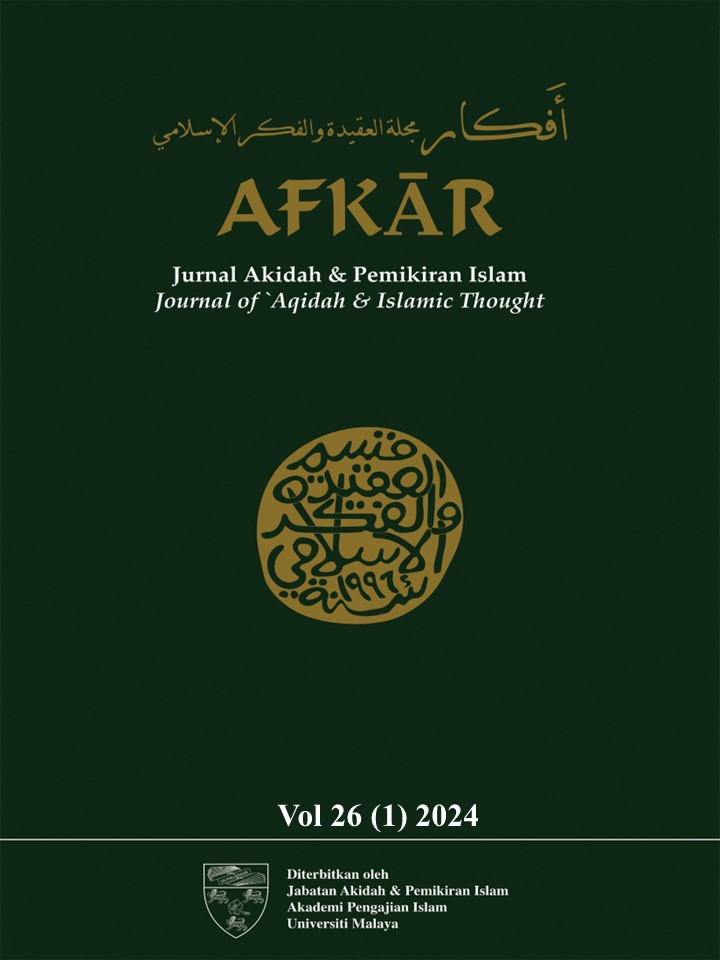Ritual and Sprituality: The Tradition of the Tariqah Naqshabandiyyah Khalidiyyah Jalaliyyah in Indonesia
Main Article Content
Abstract
The Sufi Order, known as tariqah, played a significant role during the initial Islamization period in Indonesia, further solidifying the distinct identity of Islam in the country. However, compared to other mainstream Islamic organizations like Nahdlatul Ulama and Muhammadiyah, tariqah has received relatively little study. In light of recent developments in Indonesia, particularly the conservative turn in Indonesian Islam, there is an increased significance in studying tariqah. This is because it provides insights into the diversity within Indonesian Islam, highlighting that the phenomenon of the conservative turn is not monolithic. Through observation and interviews, this article explores the rituals of the tariqah Naqshabandiyyah Khalidiyyah Jalaliyyah, which are routinely conducted based on Sufi spiritual concepts such as purification, admission, and illumination. These phases aim to enhance the spirituality of tariqah members through moral purification. This underscores that the essence of the ritual is to gradually and cumulatively improve the spiritual quality of its members. The transformation from one phase to another reflects the caliber of its members, ultimately leading to the attainment of the perfect man, a concept describing spiritual perfection for both worldly life and the hereafter.
Downloads
Article Details

This work is licensed under a Creative Commons Attribution-NonCommercial 4.0 International License.
References
Ali, Mukti, Nadhifah, Ulfiayatun & Arenggoasih, Wuri. “Klenteng Mosque’s Religious Moderation: Intercultural Communication and Remarking Da’wah of Wasathiyah Islam.” Jurnal Dakwah Risalah 33(1) (2022): 57-70.
Azra, Azyumardi. “Distinguishing Indonesian Islam: Some Lessons to Learn.” In Islam in Indonesia: Contrasting Images and Interpretations, eds. Jajat Burhanudin & Kees van Dijk. Amsterdam: Amsterdam University Press, 2013: 63-74.
Azra, Azyumardi. “Islam Indonesia: Kontribusi pada Peradaban Global.” Prisma 29(4) (2010): 83-91.
Bruinessen, Martin van. “Overview of Muslim Organizations, Associations and Movements in Indonesia.” In Contemporary Development in Indonesia Islam; Explaining the Conservative Turn, ed. Martin van Bruinessen. Singapore: ISEAS, 2013: 21-59.
Bruinessen, Martin van. Tariqah Naqsyabandiyah di Indonesia. Bandung: Mizan, 1992.
Djalaluddin, Syekh. H. Sinar Keemasan I Edisi Revisi. Surabaya: Terbit Terang, 2005.
Djalaluddin, Syekh H. Buku Penutup Umur dan Seribu Satu Wasiat Terakhir. Surabaya: Terbit Terang, 1987.
Gonggong, Anhar. “Pancasila sebagai Dasar Negara: Tantangan dan Kesalahan-Kesalahan Kita dalam Memahaminya.” Maarif 11(1) (2016): 16-40.
Haque, Amber. “Religion and Mental Health: The Case of American Muslim.” Journal of Religion and Health 43(1) (2004): 45-58.
Huda, Sokhi. “Karakter Historis Sufisme Masa Klasik, Modern dan Kontemporer.” Teosofi 7(1) (2017): 64-95.
Jalaluddin, Sinar Keemasan II. Jakarta: Terbit Terang, 1987.
Mahjuddin. Kuliah Akhlaq Tasawuf. Jakarta Pusat: Kalam Mulia, 1996.
Masduki, Toni Hartono & Imron Rosidi. “Harmoni Lingkungan di Dunia Tariqah Qadiriyah Wa Naqsabandiyah Desa Lalang Tanjung, Riau.” Al-Tahrir 17(2) (2017): 289-309.
Mohamad al-Merbawi, Abdul Manam, Abdullah, Mohd. Syukri Yeoh, Wan Abdullah, Wan Nasyrudin, Ahmad, Salmah & Abdullah, Osman Chuah. “Tariqah Naqshabandiyyah Khalidiyyah in Malaysia: A Study on the Leadership of Haji Ishaq bin Muhammad Arif.” Miqot XXXVI(2) (2012): 299-319.
Musthofa, Chabib. “Relasi Murshid dan Murid dalam Bimbingan Tariqah Shadhiliyah di Pesulukan Thoriqot Agung Tulung Agung.” Teosofi 7(2) (2017): 295-329.
Nur, Fasial Muhammad. “Perspektif Zikir di Kalangan Sufi.” Substantia 19(2) (2017): 89-98.
Robertson, Roland. “Glocalisation: Time-Space and Homogeneity-Heterogeneity.” In Global Modernities, ed. Mike Featherstone, Scott Lash & Roland Robertson. London: Sage Publications, 1995: 25-44.
Rosidi, Imron, Maulana & Khotimah. “Conflict and Its Resolution in Indonesian Islam: A Case Study of Javanese Muslim Society in Riau.” Sunan Kalijaga: International Journal of Islamic Civilization 2(2) (2018): 215-233.
Rosidi, Imron. “Being Active Muslim Audiences: Reception of Thai Films in Indonesia.” Media Asia 48(4) (2021): 1-13.
Siregar, Mawardi. “Virtual Sufi Da’wah in Preserving Religious Harmony in North Sumatra.” Jurnal Dakwah Risalah 32(2) (2021): 130-146.
Siregar, L. Hidayat. “Tariqah Naqsabandiyah Syaikh Abdul Wahab Rokan: Sejarah, Ajaran, Amalan dan Dinamika Perubahan.” Miqot XXXV(1) (2011): 72-73.
Siregar, A. Rivay. Tasawuf. Jakarta: PT Rajagrafindo Persada, 2002.
Weismann, Itzchak. The Naqshbandiyya: Orthodoxy and Activism in a Worldwide Sufi Tradition. London & New York: Routledge, 2007.
“Mengenal Sosok Buya Doktor Syekh Muhammad Nur Ali Guru Besar Thariqat Naqsyabandiyah Al Kholidiah Jalaliyah,” Grapadi News, https://grapadinews.co.id/mengenal-sosok-buya-doktor-syekh-muhammad-nur-ali-guru-besar-thariqat-naqsyabandiyah-al-kholidiah-jalaliyah/ accessed March 17th, 2023.
“Manaqib Abuya Syekh Salman Daim,” Andikatalk.id, https://www.andikatalk.id/manaqib-abuya-syekh-salman-daim/ accessed March 19th, 2023.

